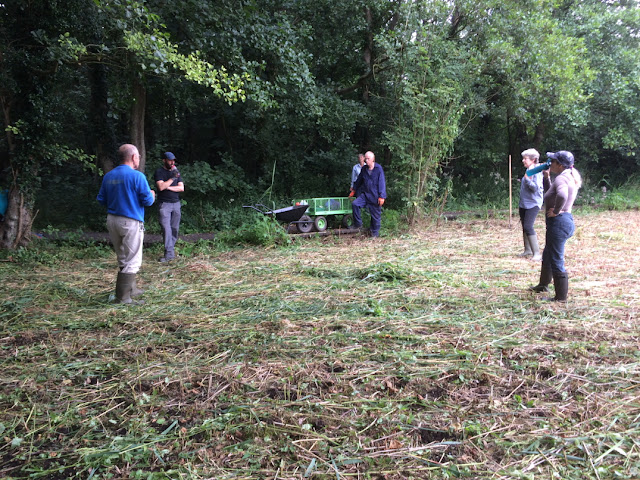In these cliché-ridden times which are it seems
unprecedented, let’s hope that this is not the ‘new normal’, but merely a
temporary phase. Like so much else, volunteering for NWT on Southrepps Commons
has been on hold, with the minor exception of a few bits of urgent maintenance
able to be done by one person, or a couple from the same household.
Nature of course has been having a high old time during the
spring and summer, as it always does. The cessation of volunteering work
actually had little effect on the Common, as it was during the period when the
place is more or left to its own devices. Swifts screamed overhead as usual,
and swallows disported themselves with gay abandon. Sadly, the bird species
most associated with the reedbed were even less noticeable than recent years; a
worrying decline. We had no reports of sedge warblers, a reed warbler sang only
briefly for a couple of weeks in July, and we may have only had one pair of
reed buntings (although a juvenile was spotted on 13th August, so
they have been quietly busy after all). On the plus side, around 100 glow worms
were lighting the darkness. Butterflies have been numerous, although not so
many species as usual have been noted. This Painted Lady turned up in pristine
condition at the start of August, probably having migrated here from somewhere
over the North Sea. It’s the only one I found, so presumably was
self-isolating.
NWT has naturally been cautious about letting volunteers loose in numbers, but now work has recommenced to kick start the new cutting season, using groups of no more than six volunteers. Today there was a working party, but not as it used to be, oh no. The first area to be dealt with was Area B, the bit leading from Warren Road, furthest from Lower Street. This is cut every other year, and in its two years of freedom it grows rampantly, and clearing it is hard work. This year the job has had to be broken down into stages spread across three days.
The first task was to remove as many alder saplings as
possible, to prevent them being coppiced by the mower, as this sets up problems
in later years. Two stalwarts from the same household set about the task with
the trusty ‘tree popper’ on Thursday, setting the scene for stage 2…
It is always essential to create a site for the material to
be dumped, but this time that site needed extra care and room, as we have to
ensure people dealing with the dumping are kept to a minimum and properly
distanced. So that took up a lot of the second session, on Friday. At the same
time, a significant portion of the area's vegetation was cut, and left where it fell,
ready for…
Today’s third session, when six volunteers turned up earlier
than usual (to avoid the heat, which didn’t materialise, but the humidity was
uncomfortably high nonetheless), to transfer the cut material to the drag
sheets prior to being winched down to the dumping site; all with fewer people
than usual involved, and all keeping their distance from each other. The work
is always quite energetic, so keeping a safe distance from heavily breathing
colleagues was essential.
The first surprise was finding this frog on the first drag sheet to be laid out; did it hop on immediately, or had it been wrapped up in it for the last few months? If it had been, it was probably equally surprised!
We were joined for this session by George, the NWT warden for Southrepps Commons, so that he could satisfy himself that the work was being done safely. His extra muscle power was also very welcome, even though he is officially on holiday!
Here we are, eagerly waiting for the signal that the winch was ready for the first pull:
Winchman John was in his rope-handling element:
And we’re off! This is evidence that your correspondent does sometimes heave on bits of rope, although it appears in the opposite direction to Sheila. Note the interested spectators:
We usually create quite tall heaps, but that requires a couple of people helping to turn the sheets over in close proximity to each other, so that’s not possible at the moment. We therefore have had to make a lower, more spread out heap, but neat, we think you’ll agree.
One of the other casualties of the changed working arrangements is the lack of supplied catering; everyone must provide their own refreshments. A scurrilous rumour circulated that your correspondent had not brought squash as claimed - hiding behind a pile of cut grass won’t have helped:
At this point it is customary to have a photo of the assembled team enjoying the socially close refreshment break. It’s part of the pleasure of volunteering, but for now it’s a smaller and socially distanced affair.
We were very pleased with our efforts, and George was too. It might have been only possible for far fewer volunteers than usual to work, but with the tasks spread across three days we still managed to make an excellent start to cutting the area. Here’s how it looked at the end of the session:












Common looking great as a result of the A team's efforts.
ReplyDelete